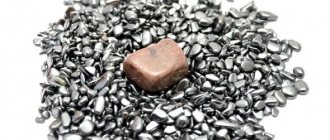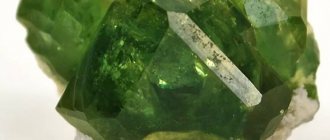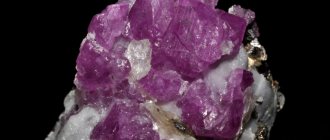Historical reference
Ammonites are a subclass of cephalopods that lived in the seas and oceans of the Earth during the Devonian (420-358 million years ago) and Cretaceous (145-66 million years ago) periods. Today, this is the name given to the fossilized shell remains of this and other species of extinct mollusks.
The oldest ammonite formations are over 400 million years old. The youngest are at least 65 million years old.
The name of the stone was given by the French zoologist Jean Brugier in 1789. "ammonitos", which sounds like Latin, has its roots in ancient times, where the amazing story of an unusual fossil began.
Information about the origin of history is found in ancient fairy tales and legends. There are 3 main versions of the origin of the name:
Ancient Egypt
Then the god Amon, the patron of the entire Universe, was especially revered.
According to the Egyptians, he had the appearance of a sun-faced ram with curled horns. The spiral curls of the stone were the personification of a special divine connection with their patron. They believed that if you put the mineral under your pillow, you would be accompanied throughout the night by colorful, voluptuous visions, perhaps even a spiritual journey. The Romans later adopted the name, giving the fossils the name "horn of Amon."
Ireland
A different name has been preserved here to this day - “petrified snakes”. As the legend says, there lived an abbess of the monastery who diligently helped all people. Residents of the area were constantly attacked by creeping reptiles.
In order to save people, the woman turned the snakes into stones. And all the creeping things began to fall from the cliffs, curling up and hardening. After this, she was canonized. Residents still believe in this legend, and stone cutters show snakehead fossils as proof of the veracity of the story.
Germany
The ammonites found there were represented as golden snails.
Finding one meant securing luck for life, finding your happiness and starting a new life. The fossils are of great interest to paleontologists and are included in the official register.
Hundreds of varieties of this stone are discovered every year. At the moment their number is more than 3 thousand.
End of the road.
The life of cephalopods is rarely long. It lasts several years and ends with the most important event - reproduction. By the time they reach maturity, the behavior of ammonites changes. They form clusters, the males become aggressive and can damage the opponent’s shell with their sharp beak.
As soon as the choice of a partner is made, the pairs unite, intertwining their tentacles. Mating, similar to a strange dance, lasts more than a day. The male transfers the spermatophore to the female and dies from exhaustion.
After a few more weeks, the females will rise to the very surface to spawn and also finish their life journey. Millions of eggs will be released into free swimming so that young ammonites begin their lives among the plankton of the Volga Sea.
For 340 million years, ammonites lived in the seas. They participated in the formation of complex ecosystem connections of ancient communities. Many common species played key roles in the food chain, serving as both predators and prey. Their breeding strategy, with a short life cycle and millions of young, was effective. It allowed for rapid evolution, adapting to the environment and creating new species. But it also made ammonites vulnerable.
The fall of an asteroid at the boundary of the Cretaceous and Paleogene launched a chain of catastrophic changes that destroyed the ecosystems of the Mesozoic. A change in the acidity of sea water led to the death of plankton, and with it, juvenile ammonites. A short-term geological event turned out to be critical for these cephalopods and caused their complete extinction.
Today their shells are the pride of many museums and private collections. They help scientists look into the distant past of our planet and understand its history. And their living relatives (albeit very distant ones) - nautiluses - make us think about caring for the environment.
quick view add to cart
Ammolite ammonite Placenticeras costatum
Price on request
quick view add to cart
Ammonites Hammatoceras sp.
69 900 ₽
quick view add to cart
Ammonite Cleoniceras sp. on a stand
13 900 ₽
quick view add to cart
Physicochemical characteristics
According to the mineralogical classification, ammonite is a paleofauna. Since 1981, it has also been officially considered an organogenic mineral.
The mineral composition and properties of the ammonite depend on the location of the shell and the nature of the surrounding waters. Sometimes a shell becomes saturated with minerals and becomes a fossil, but remains pearlescent inside. Sometimes all chambers are completely or partially filled with simbircite, sengilite, pyrite and other minerals.
The hardness of the shell is 5.5 on the Mohs scale.
Ammonite structure
Various forms of ammonite shells (from Ernst Haeckel's book "The Beauty of Forms in Nature")
Most ammonites had an external shell consisting of several whorls, located in the same plane, touching each other or overlapping each other to varying degrees. Such shells are called monomorphic . Much less frequently (mainly in the Cretaceous period) ammonites with an irregularly shaped shell— heteromorphic .
The volume of turnover reflects the ratio of subsequent turnover to the previous one. Based on this feature, ammonite shells are divided into involute (complete overlap), semi-involute and semi-evolute (partial overlap), and evolute (the subsequent whorl only touches the previous one).
The ammonite shell was divided into many chambers; the one closest to the mouth was the living chamber. The length of the living chamber varies from 0.5 to 2 turns. Most of the chambers, judging by modern nautiluses, were filled with gas (air chambers), a few with liquid (hydrostatic chambers).
Parapuzosia seppenradensis
The partition between the chambers of ammonites has a corrugated edge, which forms a complex line of attachment to the shell - the lobate line. Its structure is one of the main systematic characteristics of ammonites. There are four types of blade line.
The sculpture of the shell is also different: there are smooth and various sculptured shells with different types of branching of the ribs, location of the tubercles, etc. The sizes of ammonites are different: from 1-2 cm to 2 m in diameter (Parapuzosia seppenradensis).
According to paleontologist L.A. Doguzhaeva, some ammonites (Ptychoceras) could have a heteromorphic internal shell.
Colors and varieties
Ammonite shells
Color depends on the presence of minerals in the shell chamber. The fossil is filled with pyrites, chalcedony, jasper, simbircites and other calcites. Therefore, the shells are predominantly white, yellow, and dark honey in color.
Black fossils are rare.
If there is pyrite in the shell, a golden layer covers its surface. Specimens with mother-of-pearl inside and outside are often mined.
Ammonites with iridescent surfaces are highly prized. This rare variety is found in North America. After jewelry processing, the shells shimmer in red, green, blue, and yellow tones.
Characteristics of the stone
Externally, each stone is different from each other, but the inside is standard. Each shell has a chamber in which the mollusk used to be located. The ammonite mineral can be found anywhere on Earth, but Canada is considered the most famous deposit.
Legends about the stone
If we consider the history of this stone, it resonates in many legends of the world, in particular in Ancient Egypt, Ireland and North America. The Egyptians were convinced that these crystals were symbols of the Sun God Amon, who had unusual curled horns on his head.
In Ireland there was a legend that ammonites were snakes that were turned into stone. According to legend, the witch decided to save her village from the invasion of these creeping reptiles and turned them into statues. In North America, it is believed that ammonite is a symbol of a bull, due to its resemblance to its horns.
Locations of finds
Ammonite from Dagestan (Kuli village)
Mollusks were sea inhabitants. But over millions of years, geological changes have occurred on the earth. Therefore, today ammonites are found on almost all continents in sedimentary rocks. Archaeologists found only one example in Burmese amber.
Shells are mined in Canada, the USA, Madagascar, Morocco, Western Europe, Japan, and Australia.
In Russia, fossilized shells are found in the Krasnodar region, 120 km from Krasnodar. Samples weighing 1.3 kg and more than a meter in diameter lie here. Most often, geologists extract samples with a diameter of up to 10 cm. There are shells measuring 1-1.5 m in size. But there are also tiny ammonites – 1-2 cm.
In Germany (according to other information in Brazil), a shell with a diameter of 2.5 m was found. This sample is a record holder among ammonites.
In Morocco, Madagascar and Canada, shells with gems in the cavity are mined.
Variety of species
In nature, there are many minerals of the most bizarre shapes, colors, sizes and structures. One of the most attractive, amazing specimens is the ammonite stone.
It has a smooth surface covered with mother-of-pearl, decorated with multi-colored grooves. There are shells of all sizes: from the tiniest to the gigantic.
The color of the strange stone varies depending on the color of the minerals that fell into its chambers. The most common colors are blue, orange, green or yellow, due to the calcite and chalcedony content within. If pyrite is present, the surface will sparkle like gold.
Sometimes researchers find rare combinations of minerals. There are samples included in the calcite group. They fill the chamber with special inclusions. Ammonites filled with simbircite look like amber and carnelian. This is due to the fact that the calcite variety has a yellow-red color due to impurities of pyrite, a fossil mother of pearl.
Ammolite stone, a type of ammonite, is considered rare. Its creation requires special conditions and a lot of time. Ammolite is a stone that is formed during the mineralization of ammonite shells in rocks.
Pearlescent coating is an exceptional feature of all varieties. It remains outside and inside the stone, regardless of the number of years spent underground.
Magical properties of ammonite
This valuable stone is endowed with unprecedented power of creation and harmony. The spiral shape of the shell of a prehistoric creature resembles the rotation of stars in the Universe, the course of life itself and its development.
Ammonite earrings
Ammonite has magical properties. They consist in the radiation of harmony. It is ideal for people who want to direct their energy in one direction, make life clear and orderly.
The magic of the mineral is inextricably linked with the water element. The shell served as a bridge from the forces of water to the human spirit. With the help of the magic of the talisman, the wearer was saturated with energy and calm. There were legends that thanks to the stone, seekers used to find underground wells.
Ammonite serves as a magical amulet for everyone whose work in one way or another touches water. We are talking about sailors, submariners, rescuers, and water sports.
The stone serves as a talisman for family happiness. It was placed in the room where the family most often gathers.
In ancient times, people believed that thanks to a magical talisman they could look into the future or far into the past. The stone carried the history of past centuries. Also, its owner acquired the gift of seeing events that had not yet occurred and predicting them.
Properties and uses of stone
The mineral of organic origin is used not only for making jewelry, but also for:
- interior decoration;
- decorating countertops, coffee tables;
- decoration of clocks, aquariums, fireplaces.
It has also found application in the field of landscape design and finishing of winter gardens. The use of rock ammonite No. 1 as an explosive is interesting.
Multi-million years of energy absorption gave the ammonite interesting properties that change the course of life.
Physical properties
The mineral is of organic origin, which is why it is very fragile. It is represented by a compound of calcium carbonate and other elements.
It has a spiral structure with many chambers. The chambers start from smallest to larger ones towards the end. Opaque, iridescent.
See what ammonite looks like in processed form:
Medicinal properties
Since ancient times, the organic mineral has been used as a sedative. The ancient Arabs recommended taking mollusk shells ground into flour if it was impossible to get pregnant. The ancient Chinese believed that the stone restored the proper circulation of energy flows, thereby restoring and strengthening human health.
Other healing properties that have a beneficial effect on the body are also known:
- saves from depression and apathy;
- normalizes sleep;
- relieves nightmares;
- helps with chronic fatigue syndrome;
- prolongs the youth of the body;
- normalizes blood circulation;
- helps with bronchopulmonary diseases;
- treats skin diseases;
- increases immunity;
- strengthens the child's body.
Magic properties
Since ancient times, the mineral has been used for magical rituals.
Indian shamans used stone to seek a connection with the water element (they caused rain, found underground water). Canadian Indians believed that ammonite talismans helped in hunting large animals. Currently, sorcerers use the stone to communicate with the other world.
The unusual shape of a spiral is associated with the laws of the Universe, where everything develops in a spiral. This personifies the established order in the world, the ordering of all spheres of life.
Ammonite is a symbol of eternity; it gives the ability to feel the connection of times and longevity. The stone contains a force that strengthens the biofield and replenishes the energy balance.
Charms called “seven-color stones of prosperity” are used to attract both financial and family well-being into the home. In a work environment, talismans bring good luck in financial matters and promote career growth. The mineral is good as a wedding gift - to bring happiness to the young and material well-being.
The mineral helps researchers, archaeologists, sailors, and submariners. Amulets develop intuition.
Who is the stone suitable for according to their zodiac sign and name?
Ammonite favors people with the names: Agatha, Anna, Vera, Evdokia, Rose, Faina.
From the point of view of the zodiac signs, the stone is most suitable for Cancers, Scorpios, and Pisces.
- Aries will find good health and will be able to achieve success in difficult matters.
- For Taurus, the mineral promises prosperity, excellent results and victories.
- For Gemini, the stone will teach spirituality, cordiality, and will teach them to complete unfinished work.
- It will help Cancers strengthen relationships with family and friends, and help create comfort in life.
- For Leo, the ammonite will become a wish-fulfiller.
- Virgos will be charged with positive energy aimed at success.
- Libra's mental balance will be normalized and immunity will improve.
- Scorpios will be protected from troubles at work and material waste if their profession is related to water.
- Sagittarius will become more patient, their ardor will be balanced.
- For Capricorns, the stone will help them come to an agreement with loved ones and do something important together.
- Aquarius will be discouraged from idleness, will improve friendly contacts, and will find love.
- For Pisces, the stone will help reveal extrasensory abilities.
Additionally, watch a video review about the sacred properties of the ancient mineral:
Amulets and amulets
Ammonite
pendant Sorcerers believe that ammonite amulets have powerful powers. The shape of the shell follows the spiral structure of galaxies. Therefore, ammonite is inextricably linked with space. He receives a powerful charge of energy from it and transfers it to the owner.
The magical properties of the fossil help you look at things rationally and not lose composure in any situation.
It is dangerous to keep a shell in your pocket due to its high fragility. Therefore, wear jewelry made from it or place it in a visible place at home - a table, a fireplace, a hanging shelf.
Products made from ammonite have long been considered a symbol of wealth and family well-being. They were passed down from generation to generation and carefully preserved.
Magicians advise using small, brightly colored fossils as a talisman. They are called "seven-colored stones of prosperity." They contribute to material well-being and create an atmosphere of peace and love in the family.
Ammonite is given to newlyweds as a wedding gift.
But the shell cannot stand being near stones. Magicians do not recommend wearing ammonite jewelry with jewelry.
Compatibility with zodiac signs
Water and air are the elements that patronize fossilized prehistoric cephalopods. Decorations will not bring harm to the signs of fire and earth, but they will not be of much benefit either.
For Aries, Leo and Sagittarius, the stone will have a beneficial effect as a harmonious flow of energies that can moderate the hot ardor of the fiery signs of the zodiac. Shells are also known to have the magic of making wishes come true. Good intentions and small pranks will come true at the request of the owner of the jewelry.
Cancers are the owners of the fossilized talisman. This sign is completely susceptible to the beneficial influence of the magic of the stone. Its impact is observed in all areas of human life. Health becomes stronger, sleep improves, relationships with loved ones become gentle and tolerant. Your career will certainly take off. The ancient inhabitants of the ocean depths send harmony and order into the life of the sign of the water element.
Scorpios will be able to control their hot temper with the help of a shell talisman. Love troubles will fade into the background, and peace and tranquility will reign in the house. The magical property of the shell to give harmony is fully reflected in the ardent Scorpio.
Healing properties
Ammonite with tentacles (Reconstruction)
The healing properties of the ammonite shell were described in ancient works. Modern lithotherapists use this mineral for the same purposes as the ancient Greeks, Chinese and Arabs.
- Treatment of sleep disorders. To do this, the ammonite stone must be placed under the pillow or bed. Starting from the first night, sleep becomes sound and calm, nightmares and the feeling of morning exhaustion disappear. It can even be used by children who have difficulty falling asleep, wake up early, wake up in the middle of the night and cannot fall asleep for a long time.
- Ammonite is considered a remedy that increases a woman’s ability to conceive. Previously, couples who could not have children for a long time were prescribed ammonite powder. Now lithotherapists believe that it is enough to wear the amulet in line with the stomach. It also helps a pregnant woman bear a child and reduces the risk of complications during childbirth.
- In China, due to their shape, ammonites are used as regulators of the movement of internal energy. For this, massage and applications with ammonite stones are prescribed. They are laid out in a line along the body. This stimulates the work of all internal organs, fills the body with vital energy and strength.
- In Europe, ammonite powders and applications were used to treat skin diseases, including purulent wounds. Baths were used to strengthen nails and hair.
- Suspensions are used to prevent infectious diseases of the respiratory tract.
- Ammonite products in the children's room prevent measles, scarlet fever, and rubella.
For medicinal purposes, the configuration of the shell is important. It is necessary to use spiral-shaped shells; all others have less energy.
Areas of application
Appearance of a living ammonite
Fossilized ancient mollusks are used in two areas - jewelry, decorative and collection.
Collecting
The main segment of application of ammonite. The variety of shapes, shades, deposits, and ages allows you to create an extensive collection of the mineral.
The exhibit sizes can range from tiny to enormous.
Hobbyists are especially looking for rock ammonite - shells fused with rock.
Jewelry and decor
Mostly single craftsmen work with the mineral:
- The beauty of the mineral is evident in its cross-section, so the range of products is appropriate: flat pendants, pendants, rings, earring inserts, brooches.
- The value is influenced by the characteristics of the surface and contents. Particularly good are specimens with a preserved layer of mother-of-pearl, filled with semi-precious stones or intricately colored ones.
Each ammonite jewelry is exclusive, since the natural pattern and shape are not repeated.
Products made from ammonite have an unusual look: a pendant, brooch or ring is guaranteed to attract attention to the owner.
Medium-sized specimens make items that decorate the interior.
Where is it mined?
Fortunately, finding an ammonite is not difficult. The shells of ancient mollusks are found in many areas of the globe. The largest deposits are located in Russia, Madagascar, Canada, and the USA.
However, the ammolite mineral is mined only in Canada, Alberta.
The largest shell was found in Bavaria. The specimen was taller than human height and had a length of 2.5 meters.
Ammonites are echoes of ancient times, which give us a taste of living history. A real miracle of nature, which helps to look at them after a cosmic period of time.
Prices for ammonite products
Ammonite jewelry
Jewelry or collection value is determined by the degree of preservation of the mother-of-pearl layer or the aesthetic characteristics of the minerals that fill the shell or impregnate the walls.
You can buy the mineral at the following average prices:
- ammonite 30x30 mm – $20;
- ammonite with ammolite, polished (Madagascar, 40–45 mm) – $15-30;
- ball (74 mm) – $100;
- egg (71x41 mm) – $90;
- pendant (25–45 mm) – $15-20.
The price is affected by the composition. Thus, the cost of a pyritized agglomerate or with simbircite inside reaches thousands of dollars. The most beautiful and expensive variety of ammonites is ammolite. He is like a petrified bright rainbow.
Care and storage
Ammonite
Products made from ammonite are fragile and require careful handling. The shell will at least crack if it falls on a hard surface.
Store ammonite products on a stand out of the reach of children. For jewelry, select a separate case with a velvet lining. Do not store the shell in a soft bag. This material will not protect against impacts.
Once every six months, wash the fossil in soapy water and wipe with a microfiber cloth. Aggressive chemicals will damage the surface of the product.
Long-term exposure to sunlight and high temperatures is harmful to shells.
Mining and stone processing
You can look for ancient fossilized mollusks in almost all countries of the world. In Russia, the largest producer of the mineral, mining is most often carried out in the Krasnoyarsk and Krasnodar territories.
Foreign countries occupy high places in world production:
- Western Europe;
- USA;
- Madagascar;
- Canada;
- Japan;
- Australia;
- Bavaria.
The stone is fragile, which causes some difficulties during processing. Ammonite is sawn, polished, and cleaned of clay and impurities.
Watch a useful video on cleaning minerals:
Who is ammonite suited to according to the zodiac?
Ring with ammonite
To one degree or another, ammonite suits all zodiac signs. But first of all, astrologers recommend wearing ammonite to water and air signs.
- Aries strength to solve any problems. This zodiac sign, under the influence of the talisman, becomes successful and rich. Any difficult task is given to him easily and Aries achieves high results in solving it.
- Taurus is hardworking and can achieve career heights and financial well-being on his own, but ammonite will give energy and strengthen all the business qualities of Taurus.
- Geminis are full of plans and ideas, but their mood often changes and things remain unfinished. The talisman gives strength, patience, and determination, which allows you to bring your plans to the end.
- For Cancer , this is the best talisman with which you can make any wishes and start any business. Family occupies a special place for Cancer. Ammonite helps strengthen ties between household members.
- Leos love to be the center of attention; self-realization is important to them. Ammonite will help with this. He and Leo establish such a close connection that it is enough just to think and the wish has already come true.
- Virgo becomes harmonious and successful. The talisman adds energy and positivity, enhancing the positive qualities of the sign.
- Libra with ammonite will even out your mood, learn to deeply understand the world, and strengthen your intuition. The talisman will also improve the health of this sign.
- The character of Scorpio is tough and strong, ammonite will add softness, warmth, teach you to better understand others, and show the world in a different, more positive light.
- Sagittarians are ardent, passionate and impetuous. They do not know how to wait for the right moment and act on emotions. The talisman will add rationality and patience.
- For Capricorns, ammonite will be a means to unite the family and improve relationships with loved ones.
- Aquarius to indulge in idleness and will direct energy to creation, achieving goals and implementing plans that have been postponed until later. It will also strengthen ties with family and prevent outbursts of hysteria from ruining family relationships.
- Ammonite and Pisces are a great match for each other. Cold and apathetic fish, under the influence of the talisman, seem to wake up, become active, perky and look at the world optimistically.
When choosing a talisman, you need to rely on intuition. If the horoscope speaks of absolute compatibility, but the soul is not in love with jewelry, then it is better not to use it, because individual character traits and energy make adjustments to the ideal description of the stone made by astrologers.
There are many mysteries and secrets in history. Man can only guess what the world was like many millions of years ago. The earth has preserved some hints of this, preserving the remains of ancient lizards, mollusks, insects and plants. Ammonites are one such hint; they are part of the history of our planet.
Sources and literature
- Drushchits V.V. Lower Cretaceous ammonites of the Crimea and the North Caucasus. Lithoceratids, tetragonitids and phylloceratids.
- Rogov M., Nelikhov A. Giant horns of Amun // Paleomir. - 2008. - No. 1 (4). - pp. 32-47
- Ammonites / Chesunov A.V. // A - Questioning. - M.: Great Russian Encyclopedia, 2005. - P. 620. - (Big Russian Encyclopedia: [in 35 volumes] / chief editor Yu. S. Osipov; 2004-2017, vol. 1)
- Ruppert E. E., Fox R. S., Barnes R. D. Lower coelomic animals // Invertebrate Zoology. Functional and evolutionary aspects = Invertebrate Zoology: A Functional Evolutionary Approach / trans. from English T. A. Ganf, N. V. Lenzman, E. V. Sabaneeva; edited by A. A. Dobrovolsky and A. I. Granovich. — 7th edition. - M.: Academy, 2008. - T. 2. - 448 p. — 3000 copies.
- Fundamentals of paleontology: Handbook for paleontologists and geologists of the USSR: in 15 volumes / chapter. ed. Yu. A. Orlov. - M.: Publishing House of the USSR Academy of Sciences, 1962. - T. 5: Mollusks - Cephalopods. I / ed. V. E. Ruzhentseva. - P. 243. - 442 p.
- Count de Buffon. General and private natural history. — 3rd ed. with additions and corrections. - St. Petersburg: Imperial Academy of Sciences, 1801. - 380 p.
- Ammonites on the Wikipedia page ru.wikipedia.org.
5 / 5 ( 13 votes)
History and origin
Ancient nautiluses are of great value to science. The stone, with the imprint of sea animals, tells a lot of things. With the help of fossils, scientists determine the geological age of a rock and track the biological evolution of all life on the planet.
Historically important are the finds of cephalopod fossils, which indicate that marine predators lived on the planet in the Paleozoic era, from the fourth to the last Cretaceous geological period. During one of the five great mass extinctions, cephalopods ceased to exist.
It is known that ammonites received their name in the 1st century AD thanks to the ancient Roman writer Pliny the Elder. The spiral-shaped shells of ancient organisms resemble the curled horns of a ram, which were possessed by the ancient Egyptian god named Amon, the lord and ruler of the black, heavenly space.
In the mid-18th century, the French biologist and naturalist Count de Buffon gave a detailed description of the fossils of marine organisms. At that time, one genus of ammonites was known, but today there are more than 3 thousand species. At that time, Europeans called fossilized shells “twisted stones.”











